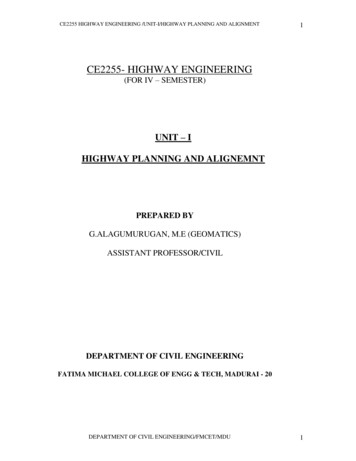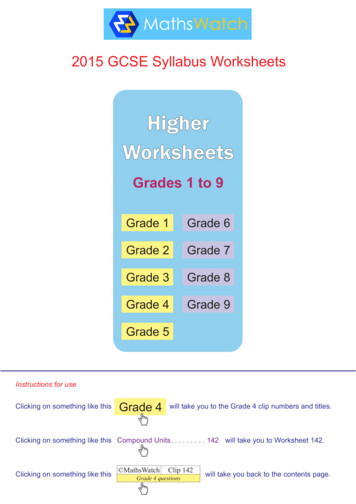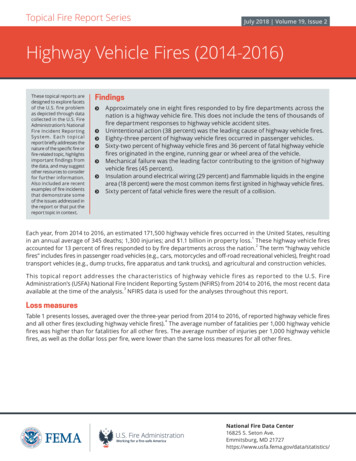
Transcription
2. Government Accession No.1. Report No.Technical Report Documentation Page3. Recipient's Catalog No.FHWA/TX-01/1845-24. Title and Subtitle5. Report DateAT-GRADE INTERSECTIONS NEAR HIGHWAY-RAILROADGRADE CROSSINGSJanuary 2001Resubmitted: August 20016. Performing Organization Code7. Author(s)8. Performing Organization Report No.Mark D. Wooldridge, Daniel B. Fambro, Marcus A. Brewer, Roelof J.Engelbrecht, Scott R. Harry, and Hanseon ChoReport 1845-29. Performing Organization Name and Address10. Work Unit No. (TRAIS)Texas Transportation InstituteThe Texas A&M University SystemCollege Station, Texas 77843-313511. Contract or Grant No.12. Sponsoring Agency Name and Address13. Type of Report and Period CoveredTexas Department of TransportationResearch and Technology Implementation OfficeP. O. Box 5080Austin Texas 78763-5080Research:September 1998-August 2000Project No. 0-184514. Sponsoring Agency Code15. Supplementary NotesResearch performed in cooperation with the Texas Department of Transportation and the U.S. Department ofTransportation, Federal Highway Administration.Research Project Title: Geometric Design Guidelines for At-Grade Intersections near Highway-RailroadGrade Crossings16. AbstractThe design of at-grade intersections near highway-railroad grade crossings is challenging because of theinteraction between the two geometric features. Their designs can have a critical effect on safety andoperation at both features. This report provides background information regarding a number of issues relatedto the following specific areas: traffic control devices, signal interconnection, channelization, high-profile or“hump” crossings, and illumination.17. Key Words18. Distribution StatementHighway-Railroad Grade Crossings, At-GradeIntersection, High-Profile Grade Crossing, HumpCrossing, Illumination, ChannelizationNo restrictions. This document is available to thepublic through NTIS:National Technical Information Service5285 Port Royal RoadSpringfield, Virginia 2216119. Security Classif.(of this report)20. Security Classif.(of this page)21. No. of PagesUnclassifiedUnclassified108Form DOT F 1700.7 (8-72)Reproduction of completed page authorized22. Price
AT-GRADE INTERSECTIONS NEARHIGHWAY-RAILROAD GRADE CROSSINGSbyMark D. Wooldridge, P.E.Associate Research EngineerTexas Transportation InstituteDaniel B. Fambro, P.E.Research EngineerTexas Transportation InstituteMarcus A. BrewerAssistant Transportation ResearcherTexas Transportation InstituteRoelof J. EngelbrechtAssociate Transportation ResearcherTexas Transportation InstituteScott R. HarryGraduate AssistantTexas Transportation InstituteHanseon ChoGraduate AssistantTexas Transportation InstituteReport 1845-2Project Number 0-1845Research Project Title: Geometric Design Guidelines for At-Grade Intersections nearHighway-Railroad Grade CrossingsSponsored by theTexas Department of TransportationIn Cooperation with theU.S. Department of TransportationFederal Highway AdministrationJanuary 2001Resubmitted: August 2001TEXAS TRANSPORTATION INSTITUTEThe Texas A&M University SystemCollege Station, Texas 77843-3135
DISCLAIMERThe contents of this report reflect the views of the authors, who are responsible for thefacts and accuracy of the data presented herein. The contents do not necessarily reflect theofficial views or policies of the Texas Department of Transportation (TxDOT) or the FederalHighway Administration (FHWA). This report does not constitute a standard, specification, orregulation, nor is it intended for construction, bidding, or permit purposes. This report wasprepared by Mark D. Wooldridge (TX-65791), Daniel B. Fambro, Marcus A. Brewer, Roelof J.Engelbrecht, Scott R. Harry, and Hanseon Cho.v
ACKNOWLEDGMENTSThe project team recognizes Mario Medina, project director; Thomas Beeman, programcoordinator; and Gus Lopez, technical panel member, for their time in providing direction andcomments for this study. Research was performed in cooperation with the Texas Department ofTransportation and the U.S. Department of Transportation, Federal Highway Administration.Some of the traffic control device drawings are from R.C. Moeur’s Manual of TrafficSigns, (http://members.aol.com/rcmoeur/). The drawings are reproduced from the website bypermission. The authors thank Mr. Moeur for the use of the drawings.The authors would also like to thank Ivan Lorenz and Crystal Garza for helping withreport preparation efforts.vi
TABLE OF CONTENTS1INTRODUCTION . 12SURVEY OF TxDOT DESIGN PRACTICES AND PROBLEMS. 3Summary of Survey Results. 3Conclusions. 133TRAFFIC CONTROL DEVICES. 15Current Standards—2000 MUTCD and Others. 15Preemption of Traffic Signals. 31Previous Research. 33Train Whistle Bans . 45Conclusions. 484INTERCONNECTION .Background .Recommendations.Conclusions.5CHANNELIZATION . 59Background . 59Islands . 62Left- and Right-Turn Lanes . 65Issues Specific to Intersections near Highway-Railroad GradeCrossings. 67Conclusions. 696HIGH-PROFILE (“HUMP”) CROSSINGS .71Existing Guidelines. 71Background . 72Conclusions .767ILLUMINATION .77Background . 77Night Visibility . 78Influence of Illumination on Railroad-Highway Grade Crossings . 79Warrant for Rural At-Grade Intersection Illumination . 81Conclusions. 848RECOMMENDED CHANGES TO THE ROADWAYDESIGN MANUAL . 8551525357REFERENCES . 87APPENDIX: SURVEY TEXT .93vii
CHAPTER 1INTRODUCTIONThe large number of crashes at grade crossings in Texas is a continuing concernof the Texas Department of Transportation. At-grade intersections near highway-railroadgrade crossings may contribute to driver confusion and traffic safety concerns. CurrentTxDOT guidelines address at-grade intersection design but do not address specialconsiderations for designing at-grade intersections near highway-railroad grade crossings.Such guidance has the potential of improving grade cross ing safety and thus, benefitingTxDOT and the driving public.This research report provides background information regarding a number ofitems that should be considered when designing at-grade intersections near highwayrailroad grade crossings: effects of variations in the distance between intersections and grade crossings; recommended regulatory, warning, and guide signs; effect of varying spacing between the intersection and grade crossing on trafficoperations; design of gradelines to avoid problems due to high-profile or “hump” crossings; effect of illumination; and effect of intersection signalization.1
CHAPTER 2SURVEY OF TxDOT DESIGN PRACTICES AND PROBLEMSResearchers conducted a survey of TxDOT district personnel to assess past andcurrent problems and/or concerns and special design considerations that have been usedwith regard to the design of highway-railroad grade crossings near highway intersections.Questions were developed regarding (but not limited to) the following areas andissues: design vehicles, vehicle storage distance, intersection turn/by-pass lanes, signage and pavement markings, and illumination.The objective of the survey was to gain more information concerning geometricdesign guidelines as they relate to intersections near at-grade highway-railroad crossings.For background and documentation purposes, the appendix contains a copy of thesurvey. A total of 11 survey responses were returned, representing 11 of TxDOT’s 25districts. The majority of the survey respondents were design engineers, although twotraffic engineers also responded to the survey.Summary of Survey ResultsThe following questions pertain to general design considerations for at-graderoadway intersections near railroad grade crossings.3
1a. Please estimate the percentage of grade crossings in your district within 200 ft of anat-grade b. What design vehicle do you use for designing at-grade intersections near railroadgrade crossings?Secondary Design VehiclePrimary Design leSchoolBusWhen do you consider the use of a secondary design vehicle?High SpeedNeverRuralSchool ZoneUrban4PassengerCarSportsUtilityVehicle
1d. For newly designed or redesigned intersections, do you give special consideration tothe approach grades to the railroad grade crossing?NoYes1e. When widening roadways toward parallel railroad tracks, have you had a problemwith the creation of “hump” crossings on intersecting roadways? (A hump crossing is ahigh profile crossing where the railroad tracks may potentially impact long truck trailerswith low ground clearances.)RuralUrbanNoNoYes5Yes
1f. If you have had problems due to the presence of “hump” crossings, please describethe problem, what actions were taken, and how the crossings were improved (ifapplicable).Three respondents reported problems.1g. Do you illuminate the railroad grade crossing if the nearby at-grade roadwayintersection is illuminated?No reported illumination, rural or urban.1h. Do you illuminate the nearby at-grade roadway intersection if the railroad gradecrossing is illuminated?Generally never, although two reported “sometimes.”1i. Do you illuminate railroad grade crossings if there is no nearby roadway intersection?None reported.2. The following questions pertain to auxiliary lanes on the roadway that parallels therailroad tracks (an operations goal sometimes is to not block through traffic on thisparallel roadway).6
2a. Do you provide turn lanes for traffic turning right toward the railroad tracks?Urban MultilaneRural MultilaneNeverNeverSometimesSometimesUrban 2-LaneRural 2-laneNeverNeverSometimesSometimes2b. Do you provide turn lanes for traffic turning left toward the railroad tracks?Rural 2-LaneUrban MultilaneNeverSometimesSometimesRural MultilaneUrban 2-LaneNeverSometimesSometimes7
2c. Does the presence of the nearby grade crossing affect the lane layout or provision ofauxiliary lanes on the roadway that is parallel to the railroad tracks in some othermanner?Urban MulitilaneRural MulitilaneSometimesSometimesNeverNeverRural 2-LaneUrban 2-LaneSometimesNeverNever3. The following questions pertain to auxiliary lanes on the roadway that intersects therailroad tracks.8
3a. Does the presence of the railroad grade crossing affect the layout of right-turn lanes?Urban 2-LaneRural 2-LaneSometimesSometimesNeverNeverRural MultilaneRural MultilaneNeverNeverSometimesSometimes9
3b. Does the presence of the railroad grade crossing affect the layout of left-turn lanes?Rural MultilaneUrban 2-LaneSometimesNeverNeverSometimesRural MultilaneRural MultilaneNeverNeverSometimesSometimes10
3c. Does the presence of the nearby grade crossing affect the lane layout or provision ofauxiliary lanes on the roadway that intersects the railroad tracks in some other manner?Urban 2-LaneRural 2-LaneSometimesSometimesNeverNeverUrban MultilaneRural MultilaneSometimesSometimesNeverNever4a. Do you provide additional signs or markings on the roadway parallel to therailroad tracks because of the closeness of the grade crossing to the at-gradeintersection?Sign or MarkingAlwaysNever40SometimesProvided1No right turn (R3-1a)060No left turn (R3-2a)060Stop here on red (R10-6)160Do not stop on tracks (R8-8)000RR advance warning (highwayparallel to railroad) (W10-2, -3, or -4)Other:11
4b. Do you provide additional signs or markings on the roadway intersecting to therailroad tracks because of the closeness of the grade crossing to the at-gradeintersection?Sign or MarkingAlwaysNeverSometimes ProvidedNo right turn (R3-1a)220No left turn (R3-2a)121Stop here on red (R10-6)252Do not stop on tracks (R8-8)423Stop ahead (W3-1a)240Signal ahead (W3-3)230Other:5. Are there locations where you prohibit vehicles stopping between the grade crossingand the parallel roadway?One reported use when clearance was less than 20 ft, using “Do not stop ontracks” (R8-8).6. Some safety devices placed at railroad grade crossings have limitations that requiremodification to allow their installation at certain locations (e.g., limits on gate length andconfiguration may require that islands be constructed, etc.). When in the design processare these limitations considered?OtherDetailed PlanPreparationPreliminaryDesignRight of WayDetermination12
7. Could you identify some potential study sites in your district (i.e., railroad gradecrossings with nearby at-grade roadway intersections)?A number of sites were suggested, generally two per survey returned. Someconsisted of corridors, although others were specific crossings.8. What guidelines or procedures do you see when designing at-grade intersections neargrade crossings? What additional guidance do you feel is needed for the design of atgrade intersections near railroad grade crossings?The design manual and guidelines produced by the American Association of StateHighway and Transportation Officials (AASHTO) were generally cited. Respondentsgave consideration to approach grades, special signage, illumination, and traffic signalcoordination. Additional guidance to the motorist was cited as desirable to aid theaccuracy of the driver’s perception of the speed of the approaching train.ConclusionsResearchers judged a number of issues to be significant regarding the design ofat-grade highway intersections and highway-railroad grade crossings based on the surveyresults: A number of different design vehicles are used in the districts. Hump crossings are a common problem in both urban and rural locations thatare frequently not treated. The illumination of highway-railroad grade crossings is generally notattempted. The provision of and design of turn lanes are frequently affected by thepresence of the highway-railroad grade crossing.The issues raised in the survey demonstrate the presence of a significant number ofpotential areas of concern. Combined with information and findings contained in theliterature, these issues indicate a need for guidance regarding the design of highwayrailroad grade crossings near highway intersections.13
CHAPTER 3TRAFFIC CONTROL DEVICESIntersections near highway-railroad grade crossings involve multiple types oftraffic: vehicles, trains, and pedestrians. These intersections require special trafficcontrol devices to properly coordinate the movements of these various types of traffic.There are several levels of traffic control at highway-railroad grade crossings, dividedprimarily into passive and active control devices. The most basic of these devices,passive devices, provide static messages of warning, guidance, and perhaps actionrequired by the driver. Among these passive devices are signs and pavement markings.For more advanced traffic control, active control devices are necessary; these devicesgive warning of the approach or presence of a train and are activated by the passage of atrain over a detection circuit in the track. Active control devices are supplemented by thesame signs and markings used in passive control. Currently, there are a number ofstandards in place for the design and installation of these devices, and research is beingperformed to find new and more efficient uses for these devices.Current Standards—2000 MUTCD and OthersThe Texas Manual on Uniform Traffic Control Devices (MUTCD) is whatgoverns design practices in Texas; the most current version of the Texas MUTCD shouldbe consulted for specific information pertinent to Texas. However, the federal version ofthe MUTCD provides the majority of national standards and guidance on a variety oftraffic control conditions, one of which is intersections near highway -railroad gradecrossings. In the Millennium Edition (2000 Edition) of the MUTCD, Part VIII containsthe vast majority of information on the subject and is divided into four major sections:General, Signs and Markings, Illumination, and Flashing-Light Signals and Gates. Otherreferences to relevant traffic control devices are found in Sections 2A and 5F. Thefollowing sections correspond to the sections in Part VIII and reference material in the2000 MUTCD (1), as well as related material from other sources.15
GeneralSection 2A of the 2000 MUTCD contains general guidelines and standards for theuse of all signs. It states that “the functions of signs are to provide regulations, warnings,and information for road users.” It further states that “the use of signs should be based onengineering judgment. Results from traffic engineering studies of physical and trafficfactors should indicate the locations where signs are deemed necessary.”Section 8A.1 provides an introduction to traffic control at highway-railroad gradecrossings. It states that “traffic control for rail roadway intersections include all signs,signals, markings, illumination, and other warning devices and their supports alongroadways approaching and at railroad crossings at grade. The function of this trafficcontrol is to permit safe and efficient operation of both rail and roadway traffic at gradecrossings.” The 2000 MUTCD recognizes that any crossing of a public road and arailroad is situated on a right-of-way available for the joint use of both roadway andrailroad traffic. This joint occupancy requires joint responsibility in the traffic controlfunction between the public agency and the railroad in order to consider the safety andintegrity of operations by both roadway and railroad users.Sections 8A.2 and 3 describe the use of standard devices and uniform provisions.It advises that no single standard system of active traffic control devices is universallyapplicable for all roadway-rail intersections. The appropriate traffic control systemshould be determined by an engineering study. A standard is set forth that, prior toinstallation of a new or modified traffic control system, approval shall be obtained fromthe public agency with the jurisdictional and/or statutory authority, and the railroadshould be notified. All signs used in railroad intersection traffic control systems shall beretroreflectorized as described in Section 2A.18 to show the same shape and color to anapproaching motorist during both day and night. Where the distance between tracks,measured along the roadway, exceeds 30 m (100 ft), additional signs or other appropriatetraffic control devices should be used.Signs and MarkingsThe 2000 MUTCD provides specifications for the use of certain specific signs andmarkings that are used at or near highway -railroad grade crossings. Section 8B.1 states16
that the purpose of passive traffic control systems, consisting of signs and pavementmarkings, is to identify and direct attention to the location of a rail-roadway interactionand advise roadway users and pedestrians to take appropriate action.The first sign discussed in the 2000 MUTCD is the RAILROAD CROSSING(Crossbuck) sign (R15-1, -2), which is discussed in Sections 5F.2 and 8B.2. Thecrossbuck sign (R15-1) shall be used at all highway-railroad grade crossings and shall beinstalled on the right side of the roadway on each approach to the rail-roadwayintersection. If an engineering study determines that unfavorable road geometry resultsin restricted sight distance on the right side of the roadway, a second crossbuck sign shallbe provided for the approach, possibly placed back-to-back with the crossbuck signfacing the opposite approach. If there are two or more tracks between the signs, thenumber of tracks shall be indicated on a supplemental sign (R15-2), except that use of theR15-2 sign is optional at crossings with automatic gates. The crossbuck sign shall beretroreflectorized white with black lettering, mounted as shown in Figure 1. (1)The RAILROAD ADVANCE WARNING signs (W10-1, -2, -3, -4) are describedin Sections 5F.3 and 8B.3. A W10-1 sign shall be used on each roadway in advance ofevery roadway-rail intersection except: 1) on low-volume, low-speed roadways crossingminor spurs or other tracks that are infrequently used and which are flagged by traincrews; and 2) in the business districts of urban areas where active roadway-railintersection traffic control devices are in use. On divided highways and one-way roads,an additional W10-1 sign may be erected on the left side of the roadway. W10-2, -3, and-4 signs may be installed on highways that run parallel to railroads to warn motoristsmaking a turn that they will encounter a railroad crossing soon after making the turn.Where the distance between the railroad and the parallel roadway is 30 m (100 ft) ormore, a W10-1 sign should be installed in advance of the roadway-rail intersection, andthe W10-2, -3, or -4 signs on the parallel roadway should not be used. Examples of theW10-1, -2, -3, and -4 signs are shown in Figure 2. (1)17
9"" )48 m.2(11 8"(4 5 0 m m )9"9 " (2 2 5 m m )9 " (2 2 5 m m )2 7"(6 7 5 m m )9'(2 .7 m )H eig h t M ay be Variedas R eq u ired by L ocalC o nd itio n s.R o adw ayL ev elFigure 1. Railroad-Highway Crossing (Crossbuck) Sign. (1)18
Figure 2. Railroad Advance Warning Signs. (1)Supplemental signs are used to indicate crossings that meet certain requirementsfor exemption. EXEMPT crossing signs (R15-3, W10-1a) are described in Section 8B.4of the 2000 MUTCD. These supplemental signs inform drivers of regulated vehicles(vehicles carrying passengers for hire, school buses carrying children, or vehiclescarrying flammable or hazardous materials) that a stop is not required at certaindesignated grade crossings, except when a train, locomotive, or other railroad equipmentis approaching or occupying the crossing, or the driver’s view of the sign is blocked.When authorized by law or regulation, a supplemental sign (R15-3) bearing the wordEXEMPT may be used below the crossbuck sign and track signs at the crossing. Thesupplemental sign (W10-1a) may be used below the RAILROAD ADVANCEWARNING sign. An example of R15-3 and W10-1a is shown in Figure 3. (1)19
Other supplemental signs discussed in the 2000 MUTCD include the DO NOTSTOP ON TRACKS sign (R8-8) and the TRACKS OUT OF SERVICE sign (R8-9),which are found in Sections 8B.6 and 8B.8, respectively. Whenever an engineering studydetermines that the potential for vehicles stopping on the tracks is high, an R8-8 signshould be used. Placement of R8-8 signs should be determined as part of the study.When used, the R8-8 sign should be located on the right side of the road on the near orfar side of the intersection, whichever provides better visibility to approaching drivers.On divided roadways and one-way roads, a second sign may be placed on the near or farleft side of the grade crossing to further improve visibility. The R8-9 sign may be used ata crossing in lieu of RAILROAD CROSSING signs (R15-1, -2) when railroad trackshave been temporarily or permanently abandoned and their use discontinued, but onlyuntil such time that the tracks are removed or paved over. When tracks are not in service,traffic control devices and gate arms shall be removed, the signal heads removed orturned from view to clearly indicate that they are not in operation, and all related signsand markings shall be removed. The R8-9 sign shall be removed when the tracks havebeen removed or covered, or when the intersection is returned to service. Examples ofthe R8-8 and R8-9 signs are given in Figures 4 and 5. (1)Figure 3. EXEMPT Sign. (1)20
Figure 4. DO NOT STOP ON TRACKS Sign. (1)Figure 5. TRACKS OUT OF SERVICE Sign. (1)Certain roadway intersections have geometric considerations that requirerestrictions on turning movements. According to Section 8B.5, at a signalized roadwayintersection that is located within 60 m (200 ft) of a roadway-rail where the roadway21
intersection traffic control signals are preempted by the approach of a train, all existingturning movements toward the roadway -rail intersection should be prohibited during thesignal preemption sequences. A blank-out or changeable message and/or appropriatetraffic signal display or other similar type sign may be used to prohibit turningmovements during preemption; these displays shall be visible only when the turnrestriction is in effect.STOP (R1-1) or YIELD (R1-2) signs may be used at highway -railroad gradecrossings, at the discretion of the responsible state or local jurisdiction, for crossings thathave two or more trains per day and are without automatic traffic control devices.Section 8B.7 describes “two or more trains” as an average of two or more trains operatingover the roadway-rail intersection each day for a period of one year prior to theinstallation of the STOP or YIELD sign. Other crossings with passive protection mayuse STOP or YIELD signs after a traffic engineering study establishes the need for thesigns. The study should take into consideration such factors as volume and character ofaccident history, as well as the need for active control devices. When a STOP or YIELDsign is installed at a grade crossing, it should be erected on a separate post at a pointwhere the vehicle is to stop, or as near to that point as possible. For all crossings whereSTOP or YIELD signs are installed, the placement shall conform to the requirements ofSection 2B-9; STOP AHEAD (W3-1a) or YIELD AHEAD (W3-2a) advance warningsigns shall also be installed. (1)The 2000 MUTCD provides standards for pavement markings in Section 8B.9.Pavement markings in advance of a roadway -rail intersection shall consist of an X, theletters RR, a no-passing marking (for two-lane roads), and certain transverse lines.Identical markings shall be placed in each approach lane on all paved approaches tointersections where signals or automatic gates are located, and at all other roadway-railintersections where the posted or statutory speed is 60 km/h (40 mph) or greater. Atminor roadway-rail intersections where the posted or statutory speed is less than 60 km/h(40 mph) or in urban areas, these markings shall not be required if an engineering studyindicates that other installed devices provide suitable warning and control. The markingsshall also be placed at roadway-rail intersections where engineering studies indicatesignificant potential for conflict between vehicles and trains. All markings shall be22
retroreflectorized white except for no-passing markings, which shall be retroreflectorizedyellow. When pavement markings are used, a portion of the X symbol should be directlyopposite the ADVANCE WARNING sign. The X symbol and letters should beelongated to allow for the low angle at which they will be viewed. (1)Stop lines should be placed at a point where the vehicle driver has adequate sightdistance along the track to determine whether it is safe to cross the track. Guidance in the2000 MUTCD states that the Stop line should be a transverse line at a right angle to thetraveled way and placed approximately 4.5 m (15 ft) from the nearest rail. The distancebetween the Stop line and the nearest rail may be reduced to a minimum of 2.4 m (8 ft)when necessary to allow for adequate sight distance. (1)Whenever conditions are sufficiently abrupt to create a hang-up of longwheelbase vehicles or trailers with low ground clearance, the 2000 MUTCD states thatthe “Low Ground Clearance” (W10-5) warning symbol sign shall be installed in advanceof the crossing. New warning symbol signs such as this may not be readily recognizableby the public and shall be accompanied by an educational plaque, which is to remain inplace for at least three years after initial installation. (1)IlluminationIllumination devices are supplemental to traffic control devices, but there areguidelines for their use. At highway-railroad
veh icle storage distance, intersection turn/b y-pass lanes, signage and pavement markings, and illumination. The objective of the survey was to gain more information concerning geometric design guidelines as they relate to intersections near at-grade highway-railroad crossings.










